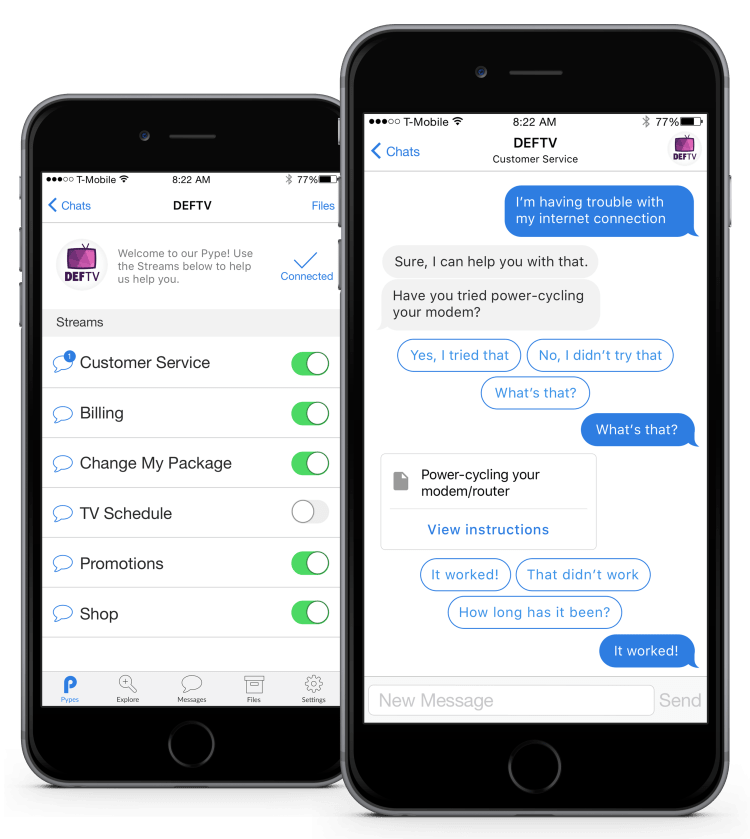Over the past year, artificial intelligence has made big headlines for everything from Siri’s new capabilities to smart assistants. Although A.I. technologies like self-driving cars may be more thrilling, there is one innovation that hits close to home for all of us: chatbots.
Chatbots provide companies with a novel way of engaging with customers, one that is as imminently promising as it is potentially harmful to the customer experience. As more companies begin to incorporate A.I. and autonomous systems into their operations, we are about to see a massive uptick in the usage of these types of bots. In fact, we already are. So how do we find the right mix of bot and human in order to maintain the highest level of customer service?
Customer service benefits
The biggest benefit of a chatbot to the customer service industry is the ability to engage users without the need to hire and manage an increased workforce. The cost-saving aspect of chatbots cannot be overstated. If bots prove an effective alternative, they present a tremendous opportunity for businesses to scale, pivot, and expand customer service operations globally at a reduced cost.
The technology is improving. Chatbots are becoming smarter and more sophisticated. The caveat is that bot intelligence relies on input from their creator, which means that there is only so much a bot can do (e.g., whatever it is programmed to do), and it can’t know what it doesn’t know.
Further, A.I. can be easily duped or misdirected, as we saw when Microsoft attempted to engage millennials with the creation of the Tay chatbot on Twitter. If a customer service chatbot were to learn inappropriate commands like Tay, it could have a serious negative impact on the company’s brand. More insidious, if a bot became patently unhelpful without being openly offensive, it could cause frustration for an extended period of time without being flagged as doing so.
It’s early in their evolution
If chatbots are to be the next major innovation in customer service technology, we need to understand both their strengths and their weaknesses, and the fragile balance between the computational ability and emotional intelligence needed to interact with real, live humans. Although a good chatbot will give you the illusion that you are interacting with another human, it will never be able to fully understand the subtle nuances of human emotion. As humans, we’re empathetic, we know when to listen and when to interject, and we understand the root cause of frustration and panic. But a bot can’t pick up on these cues.
When you see an unauthorized charge on your credit card and log onto your bank’s website, a chatbot may engage with you. You’re already irritated, perhaps panicking because your card has been maxed out on purchases you never made. The bot will be able to look at your account, calculate numbers, and offer you a multitude of different fact-based options, but none of these capabilities will be able to address the immediate sinking feeling a human has when his or her privacy has been breached.
They do play a role
So, what role do chatbots play in customer service?
Chatbots are best used for closing the gaps in a company’s self-service offering. Simple, repetitive tasks such as checking inventory, updating delivery times, and finding relevant information about a user are all things that can and should be automated. To the extent possible, the use of bots should be avoided for tasks that can be handled by an updated version of your UI. If a task is simple enough to automate a bot to do it, why not just build it into the UI?
Chatbots also incorporate well with tools customers already use like Facebook Messenger or SMS. Earlier this year, Facebook announced that it will be implementing A.I. bots into its Messenger and WhatsApp platforms, which are currently used by more than 1.8 billion people worldwide. The chatbots will help users with tasks such as making dinner reservations, searching for products online, and inviting friends to events. These types of integrations make it easier for a user to ask questions, perform queries, and find relevant information without having to switch their mode of communication.
Most importantly, chatbots must be taught the same core principle that is taught to all customer service representatives: Know when to escalate. Bots should recognize situations in which customers require human intervention and be equipped with tools that allow them to do so seamlessly. More to the point, customers must be given the option to escalate themselves and gain immediate access to a human being, preferably via phone, so that their situation can be quickly resolved without frustration and churn. This measure is particularly important as businesses “work out the kinks” of chatbot customer service.
They will never fully replace humans
Bots should come to represent a shift in the customer service arena that will allow (human) support teams to become more highly skilled strategic assets. Bots are very much a means to an end. They can help answer easy questions, facilitate simple tasks, and, when they are in over their circuits, escalate the customer to a human representative.
The future of customer service isn’t just in chatbots and automated tools. Companies that succeed will find the right mix of A.I. and human representatives, using both to the best of their abilities and in conjunction with one another.
Note: An original version of this article contained unattributed material which has been removed.
VentureBeat's mission is to be a digital town square for technical decision-makers to gain knowledge about transformative enterprise technology and transact. Learn More

